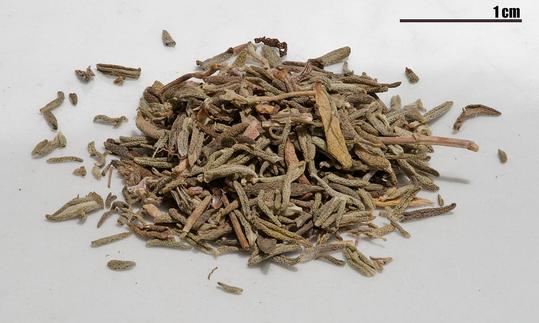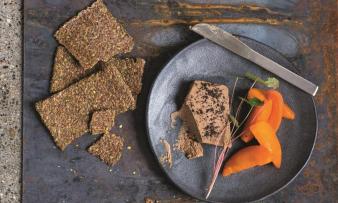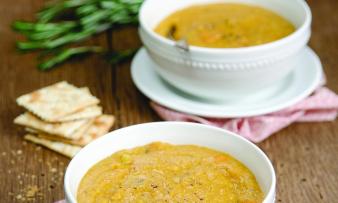Table of contents
Dried thyme ( Thymus vulgaris ) is a popular herb ( organic? ). Conventionally produced, usually not in raw food quality.
Use in the kitchen
Thyme is an important herb. Only the leaves and flowers are suitable for consumption. When dried gently, it can still be considered raw food. Fresh thyme does not keep for as long. Dried thyme is therefore more popular for reasons of durability and easier dosing. It tastes slightly sweet and at the same time a little tart and bitter.
How can you use dried thyme? The herb goes well with most Mediterranean dishes and is particularly good with tomatoes , sweet potatoes and pumpkin . It can be used to season soups, hearty stews and baked vegetables. Thyme is found in most " Herbs de Provence " mixtures along with dried oregano , rosemary and savory . Sometimes sage , bay leaves , basil and marjoram are also mixed in.
Making your own dried thyme
Thyme should be harvested before it flowers, as this is when its aroma is strongest. Cut the thyme shoots off with sharp scissors or a knife in the late morning. It is important that the herb is dry. So you should not harvest it when it is raining or after rainy days. Check the shoots and remove any yellow or diseased leaves, as well as insects and dirt. However, do not wash the thyme. 3
When air drying, use a warm (20 to 30 °C) but dark, well-ventilated and dust-free room. You can tie the thyme shoots into a small bundle and hang them upside down or lay them out loosely on baking paper. 3
To dry in the oven at 30-35 °C, place the thyme shoots loosely on a baking tray lined with baking paper and let them dry slowly in the oven for 1 to 2 hours. Make sure to leave the oven door slightly open so that moisture can escape. Alternatively, you can also dry thyme in a dehydrator at a maximum of 40 °C. Drying in the microwave is possible, but we do not recommend it. 3
As soon as the bundles rustle, the stems break easily and you can rub the leaves between your fingers, the thyme is perfectly dried. Carefully strip the dried leaves from the shoots ("tear them off") and fill them into airtight containers or screw-top jars. These must be stored in a dry place protected from light. 3
Vegan recipe for lentil spread with thyme
Ingredients (for 4 people): 300 g red lentils (cooked), 1 shallot , 1 clove of garlic, 1 tbsp rapeseed oil , 50 g dried tomatoes (without oil), 1 tsp thyme,black pepper , paprika powder (sweet) .
Preparation: Boil red lentils in water (see instructions here ). Peel shallot and garlic and chop finely. Roast briefly in a frying pan with rapeseed oil. Allow lentils, shallot and garlic to cool. Put all ingredients in a blender or puree in a bowl with a hand blender. Season to taste with pepper and paprika powder.
Making tea with thyme
Thyme tea is mainly drunk for respiratory problems such as coughs and hoarseness. Pour 1 teaspoon of dried thyme per cup with hot water and leave to steep covered for 10 minutes. Filter with a sieve and sweeten with a little honey if necessary.
Vegan recipes with dried thyme can be found under the note: " Recipes that have the most of this ingredient ".
| Not only vegans or vegetarians should read this: Vegans often eat unhealthily. Avoidable nutritional mistakes . |
Purchasing - Storage
Large retailers such as Coop , Migros , Denner , Volg , Spar , Aldi , Lidl , Rewe , Edeka , Hofer and Billa sell dried thyme, some of which are organic. Health food stores and organic supermarkets such as Denn's Biomarkt and Alnatura also sell dried organic thyme.
Thyme in raw quality (gentle drying) is rare, but is available online. You can also make it yourself.
The availability of dried thyme varies depending on the size of the store, catchment area, etc. If you are interested, click on our recorded food prices for the DA-CH countries (above under the ingredient image). There you will find current prices and, by clicking, their development at various suppliers.
Storage tips
Dried thyme should be stored in glass or metal containers protected from light and moisture. Plastic containers should be avoided as these can attack the essential oil.
Ingredients - Nutritional values - Calories
Here we realistically show you the ingredients of spices and herbs per 1 g (instead of per 100 g as usual).
1 g of dried thyme (raw) has a calorie content of 2.76 kcal. It contains 0.64 g of carbohydrates, 0.09 g of protein and 0.07 g of fat per gram of thyme. 1
Dried thyme contains a high proportion of vitamin K. 1 g contains 17.1 µg, which corresponds to 22.9% of the daily requirement. Only dried wild garlic has a higher content at 26.25 µg/1g. 1 The iron content is also very high. The 1.24 mg/1g contained corresponds to 8.83% of the daily requirement. Dried basil (0.98 mg/1g) and dried marjoram (0.83 mg/1g) have a similarly high iron content. 1
Thyme also contains valuable essential oils, including thymol (10-64%) and carvacrol 8 , as well as borneol, cymene, pinene, tannins, flavonoids and phenolic compounds. 2,9
The complete ingredients of dried thyme, the coverage of the daily requirement and comparison values with other ingredients can be found in our nutrient tables. In the article Nutrients explained you will get a detailed insight into the topic.
Health effects
Is dried thyme healthy? True thyme is a particularly healthy spice because of its essential oil. The effect is largely due to the thymol and carvacrol it contains. These are present in the plant and in particularly high concentrations in thyme oil, which is obtained by steam distillation. In vitro tests confirm its antioxidant, antimicrobial, expectorant and antibacterial effects. 8 Thyme also has an antiviral effect in vitro against herpes simplex viruses and influenza viruses ("flu viruses"). 9 It is therefore often used against coughs and colds (see Use as a recognized medicinal plant).
The herb also has an antispasmodic effect. 8 Studies show that thyme extracts are more effective against menstrual cramps than a common painkiller. Menstrual cramps and thus pain were relieved more quickly and effectively by taking the thyme preparation. 10
Dangers - Intolerances - Side effects
There are no studies on the consumption of thyme (Thymi herba) by children under 12 years of age, which is why the HMPC does not recommend its use as a medicinal plant. It is also not recommended for use during pregnancy and breastfeeding. 5 However, there are no restrictions on the use of thyme as a culinary herb, as the dosage is low.
Although thyme is a widely used spice, allergies are very rare. One known case is that of a 45-year-old man who had an allergic reaction after eating food containing thyme or oregano. In addition to itching and swelling of the lips and tongue, he also had difficulty swallowing, breathing difficulties, eyelid edema, hypotension (low blood pressure), vomiting and nausea. An allergic skin test showed that the man also reacted to other spices from the Lamiaceae family. The control group, on the other hand, did not react to any of the spices. 7
Thyme oil can cause skin irritation and dermatitis. 8
Is raw thyme poisonous? The toxic dose is 10 g of dried thyme per day. 8
Use as a recognized medicinal plant
According to the European Medicines Agency (EMA), the two species Thymus vulgaris and Thymus zygis or a mixture of both species are permitted for the production of the pharmaceutical drug thyme (Thymi herba) and thyme leaves (Thymi folium). The HMPC classifies the effectiveness of thyme (leaves and flowers) against coughs and colds as "traditional use". This means that despite insufficient evidence from clinical studies, the effectiveness of these herbal medicines is plausible and there is evidence that they have been used safely in this way for at least 30 years (including at least 15 years within the EU). 5 In 2003, the ESCOP published a monograph on thyme (Thymi Herba - Thyme). Thyme oil of the thymol type (Thymi typo thymolo aetheroleum) is also permitted. This is used externally (rubs, baths) and is used to relieve cold symptoms. 6
Thyme has an antispasmodic and disinfectant effect. The main active ingredient is the essential oil. Thyme tea or extracts in the form of drops or juices help against catarrh of the upper respiratory tract, coughs (whooping cough), bronchitis and relieves asthma attacks. 2,8 Thyme also stimulates the appetite and aids digestion. 2
Ecological footprint - animal welfare
The ecological CO 2 footprint of a food depends on various factors. The type of agricultural production (conventional vs. organic), average or seasonal or regional production, domestic production or import by truck, ship or plane, different types of packaging and whether the goods are fresh or frozen play a decisive role. 12 Despite extensive research, however, we were unable to find any precise information on the ecological CO 2 footprint of thyme.
Thyme is a drought-tolerant plant, so it can be grown without artificial water supplies in some cases. However, when grown commercially in areas where there is no rain in the summer, irrigation is necessary.
In conventional agriculture, synthetic herbicides and pesticides are often used to protect against unwanted plants and insects. However, these are not only proven to harm the environment, but can also have direct negative effects on humans. Residues of the pesticides used during cultivation are often found in the final product, which was also found in thyme. In several studies on pesticide residues in herbs, the amount found in thyme even exceeded the maximum permitted amount. 13,14 Ideally, you should buy herbs from organic farming or grow them yourself, which also saves unnecessary packaging and transport and the associated emissions.
Worldwide occurrence - cultivation
Thyme is originally found in the rocky heaths and evergreen bush forests of the Mediterranean region. Outside of this area it rarely grows wild. Thyme is often cultivated in gardens as it is a popular spice and medicinal plant. 2
Cultivation - Harvest
True thyme prefers a sheltered, warm and sunny location. The soil should be relatively low in nutrients, slightly sandy and permeable. Thyme can be grown well in a pot on the balcony. Thyme does not like waterlogging at all, which is why water-permeable soil with good drainage is important. 4
From the end of February, you can sow thyme for pre-cultivation so that you can plant it out in May. Alternatively, you can sow it directly outdoors between April and June. Thyme germinates in light, which means that the seeds should not be covered with soil. Thyme can be planted well next to lavender, rosemary and sage. You should not plant marjoram or peppermint next to thyme, as the herbs do not get along. 4
True thyme is winter hardy. From mid-August onwards, you should stop fertilising and cutting back the herb. Both of these things encourage the formation of new shoots, which will not fully mature by winter and can therefore freeze. You should cover the ground around the plant with fir or spruce branches to protect the roots from frost. 4
Industrial production
In commercial production, sieves or blowers clean the thyme of sand, earth or stones. Then special mills mechanically shred the thyme leaves. In industry, raw thyme leaves are mostly dried using hot air in special ovens or on belts. In freeze-drying, the herbs are shock-cooled to -18 °C using liquid nitrogen. In a vacuum, the ice that is created turns directly into a gaseous state (water vapor) and can be easily sucked off. This technique is more expensive, but ensures that the herbs retain their structure, natural color and flavor even over longer storage periods. 11
Herbs are sometimes contaminated with germs that can be harmful to health or reduce their shelf life. These are therefore removed using special steam and heat disinfection processes. Treatment with ionizing radiation is permitted within the EU . This method is not used in every EU country and some countries only import non-irradiated goods. 11
Further information
Common thyme ( Thymus vulgaris ) belongs to the genus Thyme ( Thymus ) within the family Lamiaceae. Other well-known relatives used as spices or medicinal plants are sand thyme ( Thymus serpyllum ), lemon thyme ( Thymus × citriodorus ) and broad-leaved thyme ( Thymus pulegioides ).
Alternative names
Common thyme is also called garden thyme, Roman thyme, bee herb, Kunerle, tripe herb and zimis. The English name is thyme.
Approved phytopharmaceuticals are Thymi herba, Thymi folium and Thymi aetheroleum.
Other uses
The essential oil of thyme is used in mouthwashes and bath additives (cold baths), as well as as a fragrance for freshening rooms. The leaves are also used as incense. Thyme oil also repels insects, mosquitoes, fleas, lice and moths. 8











Comments